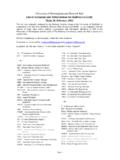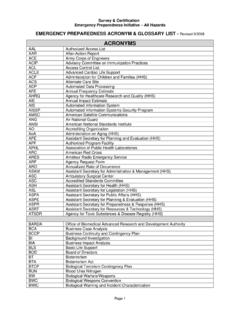Transcription of Disaster Preparedness and Response Training TM
1 Disaster Preparedness and Response TrainingTM Complete Course: Modules One, Two, & ThreeTM Facilitator s GuideTM 2014 National Center for Environmental Health Centers for Disease Control and Prevention Suggested Citation: Centers for Disease Control and Prevention (CDC). Disaster Preparedness and Response : Complete Course. Facilitator guide, first edition. Atlanta (GA): CDC; 2014. For additional information, please contact: Centers for Disease Control and Prevention Environmental Hazards and Health Effects Health Studies Branch 4770 Buford Highway, MS F-60 Chamblee, GA 30341 Phone: + 1 770-488-3410 Fax: + 1 770-488-3450 TABLE OF CONTENTS Course Overview.
2 I Course Design .. i Target audience .. i Options for Facilitating this Training .. ii Facilitator/Mentor Role and Responsibilities .. ii Icon Glossary .. iii Glossary of terms .. iv MODULE ONE: EPIDEMIOLOGIC Response TO DISASTERS Overview of Module One Epidemiologic Response to Disasters .. 4 Learning Objectives .. 5 Estimated Completion Time .. 5 Prerequisites .. 5 Lesson 1: Public Health Implications of Disasters and Hazards .. 6 Introduction .. 6 Common Types of Disasters .. 7 Effects of Disasters.
3 12 Disaster -Related Health Effects and Public Health ..15 Public Health Concerns Following a Disaster ..17 Practice Exercise ..20 Lesson 1 summary ..26 Lesson 2: The Role of Disaster Epidemiology in Disaster Preparedness and Response . 27 Introduction ..27 Goals of Disaster Epidemiology ..28 The Disaster Cycle ..28 The Role of an Epidemiologist in Disaster Preparedness and Response ..30 Special Considerations for Disaster Epidemiology ..37 Practice Exercise ..40 Lesson 2 Summary ..42 References ..43 MODULE TWO: Disaster Response RAPID NEEDS ASSESSMENT Overview of Module Two Disaster Response Rapid Needs Assessment.
4 51 Learning Objectives ..52 Estimated Completion Time ..52 Prerequisites ..52 Lesson 1: Planning a Disaster Response Rapid Needs Assessment (RNA) ..53 Introduction ..53 Overview of RNA Methodology ..54 Four Phases of an RNA ..55 RNA Purpose and Objectives ..57 Challenges to Conducting an RNA ..60 Planning for an RNA ..63 Practice Exercise ..67 Lesson 1 Summary ..69 Lesson 2: Phase 1 Preparing for an RNA ..70 Introduction ..70 Overview of RNA Sampling Method ..71 Determine the Assessment Area ..71 Two-Stage Cluster Sampling Method.
5 74 Considerations Affecting Sample Selection and Size ..78 Other Sampling Methods ..78 Practice Exercise ..82 Develop the RNA Questionnaire and Forms ..83 Identify and Train Field Interview Teams ..89 Conducting the Interview ..91 Practice Exercise ..95 Lesson 2 Summary ..96 Lesson 3: Phase 2 Conducting an RNA ..97 Introduction ..97 Administering the Questionnaire in the Field ..97 Practice Exercise .. 101 Lesson 3 Summary .. 102 Lesson 4: Phase 3 and 4 Data Entry, Analysis, and Writing the 103 Introduction.
6 103 Data Entry and Analysis .. 104 Reporting the 114 Practice Exercise .. 118 Lesson 4 Summary .. 119 Skills Assessment .. 120 Rapid Needs Assessment (RNA) Case Study: Flooding in Guatemala .. 120 Learning Objectives .. 120 Case Scenario .. 120 References .. 135 MODULE THREE: Disaster SURVEILLANCE METHODS Overview of Module Three Disaster Surveillance 144 Learning Objectives .. 145 Estimated Completion Time .. 145 Prerequisites .. 145 Lesson 1: Overview of Disaster Surveillance .. 146 Introduction.
7 146 Defining Disaster Surveillance .. 147 Disaster Surveillance: Morbidity and Mortality Considerations .. 150 Surveillance Challenges in a Disaster Setting .. 152 Lesson 1 Summary .. 155 Lesson 2: Disaster Surveillance Methods .. 156 Introduction .. 156 Planning for Disaster 157 Steps for Designing and Conducting a Disaster Surveillance System .. 158 Considerations for Designing or Using Existing Surveillance Methods .. 163 Surveillance Methods .. 165 Disaster Surveillance Indicators and Data Collection Forms.
8 167 Practice Exercise .. 171 Lesson 2 Summary .. 173 Skills Assessment .. 174 References .. 176 i COURSE OVERVIEW The Disaster Preparedness and Response Training Course has three modules. The course also has a final comprehensive capstone activity where learners apply the knowledge and skills learned in the course. After completing all three modules, you will have a better understanding of the Disaster -related rapid needs assessments and surveillance necessary to support responses to disasters and other public health emergencies.
9 Each module builds on the skills and concepts learned in the previous modules. The modules should be completed consecutively in the following order: Module One Epidemiologic Response to Disasters Module Two Disaster Response Rapid Needs Assessment Module Three Overview of Disaster -related Morbidity and Mortality Surveillance COURSE DESIGN The course uses a self-paced, learner-focused format. The majority of the instructional content for the module is contained in a Participant Workbook.
10 Learners will read through the Participant Workbook individually and stop at specified points to discuss key points and practice exercises with a mentor or a facilitator. This self-paced format allows learners to complete the Training at their own pace. It is expected that a mentor or facilitator will meet with the learner(s) periodically to review key points and address any questions. It is up to the learner and the facilitator to schedule meeting times. Depending on the number of learners, the facilitator might wish to schedule group sessions or meet individually with each learner.


















